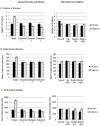Abstract Conceptual Feature Ratings Predict Gaze Within Written Word Arrays: Evidence From a Visual Wor(l)d Paradigm
- PMID: 26901571
- PMCID: PMC5156577
- DOI: 10.1111/cogs.12348
Abstract Conceptual Feature Ratings Predict Gaze Within Written Word Arrays: Evidence From a Visual Wor(l)d Paradigm
Abstract
The Abstract Conceptual Feature (ACF) framework predicts that word meaning is represented within a high-dimensional semantic space bounded by weighted contributions of perceptual, affective, and encyclopedic information. The ACF, like latent semantic analysis, is amenable to distance metrics between any two words. We applied predictions of the ACF framework to abstract words using eyetracking via an adaptation of the classical "visual word paradigm" (VWP). Healthy adults (n = 20) selected the lexical item most related to a probe word in a 4-item written word array comprising the target and three distractors. The relation between the probe and each of the four words was determined using the semantic distance metrics derived from ACF ratings. Eye movement data indicated that the word that was most semantically related to the probe received more and longer fixations relative to distractors. Importantly, in sets where participants did not provide an overt behavioral response, the fixation rates were nonetheless significantly higher for targets than distractors, closely resembling trials where an expected response was given. Furthermore, ACF ratings which are based on individual words predicted eye fixation metrics of probe-target similarity at least as well as latent semantic analysis ratings which are based on word co-occurrence. The results provide further validation of Euclidean distance metrics derived from ACF ratings as a measure of one facet of the semantic relatedness of abstract words and suggest that they represent a reasonable approximation of the organization of abstract conceptual space. The data are also compatible with the broad notion that multiple sources of information (not restricted to sensorimotor and emotion information) shape the organization of abstract concepts. While the adapted "VWP" is potentially a more metacognitive task than the classical visual world paradigm, we argue that it offers potential utility for studying abstract word comprehension.
Keywords: ACF ratings; Abstract knowledge; Eye movements; LSA cosines; Visual world paradigm.
Copyright © 2016 Cognitive Science Society, Inc.
Figures




Similar articles
-
Abstract conceptual feature ratings: the role of emotion, magnitude, and other cognitive domains in the organization of abstract conceptual knowledge.Front Hum Neurosci. 2013 May 23;7:186. doi: 10.3389/fnhum.2013.00186. eCollection 2013. Front Hum Neurosci. 2013. PMID: 23720617 Free PMC article.
-
Semantic information mediates visual attention during spoken word recognition in Chinese: Evidence from the printed-word version of the visual-world paradigm.Atten Percept Psychophys. 2016 Jul;78(5):1267-84. doi: 10.3758/s13414-016-1081-z. Atten Percept Psychophys. 2016. PMID: 26993126
-
The role of polarity in antonym and synonym conceptual knowledge: evidence from stroke aphasia and multidimensional ratings of abstract words.Neuropsychologia. 2012 Sep;50(11):2636-44. doi: 10.1016/j.neuropsychologia.2012.07.015. Epub 2012 Jul 20. Neuropsychologia. 2012. PMID: 22820631
-
Linking somatic and symbolic representation in semantic memory: the dynamic multilevel reactivation framework.Psychon Bull Rev. 2016 Aug;23(4):1002-14. doi: 10.3758/s13423-015-0824-5. Psychon Bull Rev. 2016. PMID: 27294419 Free PMC article. Review.
-
An interpretable measure of semantic similarity for predicting eye movements in reading.Psychon Bull Rev. 2023 Aug;30(4):1227-1242. doi: 10.3758/s13423-022-02240-8. Epub 2023 Feb 2. Psychon Bull Rev. 2023. PMID: 36732445 Free PMC article. Review.
Cited by
-
The Comprehension of Counterfactual Conditionals: Evidence From Eye-Tracking in the Visual World Paradigm.Front Psychol. 2019 Jun 14;10:1172. doi: 10.3389/fpsyg.2019.01172. eCollection 2019. Front Psychol. 2019. PMID: 31258498 Free PMC article.
-
What we mean when we say semantic: Toward a multidisciplinary semantic glossary.Psychon Bull Rev. 2025 Feb;32(1):243-280. doi: 10.3758/s13423-024-02556-7. Epub 2024 Sep 4. Psychon Bull Rev. 2025. PMID: 39231896 Free PMC article. Review.
-
Thematic and other semantic relations central to abstract (and concrete) concepts.Psychol Res. 2022 Nov;86(8):2399-2416. doi: 10.1007/s00426-021-01484-8. Epub 2021 Jun 11. Psychol Res. 2022. PMID: 34115192
-
"Looking at" Negation: Faster Processing for Symbolic Rather Than Iconic Representations.J Psycholinguist Res. 2021 Dec;50(6):1417-1436. doi: 10.1007/s10936-021-09797-w. Epub 2021 Sep 3. J Psycholinguist Res. 2021. PMID: 34478017 Free PMC article.
References
-
- Allman MJ, Meck WH. Pathophysiological distortions in time perception and timed performance. Brain. 2012;135(3):656–677. http://dx.doi.org/10.1093/brain/awr210. - DOI - PMC - PubMed
-
- Baayen RH, Piepenbrock R, van H R. The {CELEX} lexical database on {CD-ROM} 1993
Publication types
MeSH terms
Grants and funding
LinkOut - more resources
Full Text Sources
Other Literature Sources

